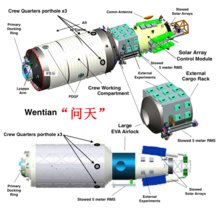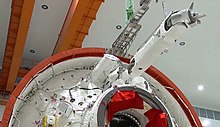Laboratory Cabin Module
Long March 5B | |
| Mass | ~21,500 kg (47,400 lb) (dry mass of each LCM) |
|---|---|
| Length | 17.9 m (59 ft) |
| Diameter | 4.2 m (14 ft) |
The Laboratory Cabin Modules (LCM) (
The first LCM, Wentian (simplified Chinese: 问天; traditional Chinese: 問天; pinyin: Wèn Tiān; lit. 'Quest for the Heavens[1]'), was launched into orbit on 24 July 2022. The second LCM, Mengtian (simplified Chinese: 梦天; traditional Chinese: 夢天; pinyin: Mèng Tiān; lit. 'Dreaming of the Heavens[1]'), was launched into orbit on 31 October 2022.[2]
Purpose


The first laboratory module provides additional navigation avionics, propulsion and
The axial ports of the LCMs are fitted with rendezvous equipment, and each first docked to the axial port of the CCM. A mechanical arm dubbed the Indexing Robotic Arm, somewhat like the Lyappa arm used on the Mir space station, moved Wentian to a starboard-side port and Mengtian to a port-side port of the CCM.[3] It is different from Lyappa as it works on a different mechanism. Lyappa arm is needed to control the pitch of the spacecraft and redocking in a different plane. But the Indexing Robotic Arm is used when docking is needed in the same plane. In addition to this arm used for docking relocation, the Chinarm on Tianhe module can also be used as a backup in place of Indexing Robotic Arm.[4][5]

Wentian was successfully relocated to the starboard port on 30 September 2022 at 04:44 UTC[6] using the indexing robot arm.
In addition to this, Wentian houses a small 5 m (16 ft) long robotic arm like the Chinarm as a supplemental to that arm. It is used for manipulating extravehicular payloads and their positioning accuracy is 5 times better than the Chinarm. There are standard adapters (silver squares) on the modules to host the payloads.
Mengtian also carries a toolbox equipped with a dexterous robotic arm (similar to the Lyappa arm used on the Mir space station) installed to assist in cargo transfer and payload release, and can be used to deploy external payloads.[9][10]
Dimensions
The length of each module is 17.9 m. They are cylindrical with a maximum diameter of 4.2 m and an on-orbit mass of approximately 20,000 kg (44,000 lb) apiece.[11][12]
Launch
Both modules were launched in 2022 on
See also
References
- ^ a b "Planned space station details made public". China Daily. 2018-04-26.
The two space labs, Wentian, or Quest for Heavens, and Mengtian, or Dreaming of Heavens
- ^ a b Jones, Andrew (31 May 2022). "Rocket to launch China's next space station module arrives at launch center". SpaceNews. Retrieved 1 June 2022.
- ^ Graham, William; Gebhardt, Chris (April 28, 2021). "China readies launch of Tianhe module, start of ambitious two-year station construction effort". NASASpaceflight.com.
This means the two future science modules, Wentian ("Quest for the heavens") and Mengtian ("Dreaming of the heavens"), cannot dock directly to their planned radial port locations. [...] To account for this, each module will carry a Russian Lyappa robotic arm — like the ones used on Mir for the same purpose — to move the module from the forward port to its respective permanent location on a radial port of Tianhe's docking hub.
- ISBN 978-9811548970.
- ^ Graham, William; Gebhardt, Chris (April 28, 2021). "China readies launch of Tianhe module, start of ambitious two-year station construction effort". NASASpaceflight.com.
- ^ "我国成功实施问天实验舱转位". 科学新闻网. Retrieved 30 September 2022.
- ^ @CNSpaceflight (July 23, 2022). "Wentian is 17.7m long and its dry mass is ~21500kg. With additional 1550kg propellant, the launch mass will be more than 23 tonnes" (Tweet). Retrieved 2022-07-23 – via Twitter.
- ^ @CNSpaceflight (July 3, 2022). "An illustration of the China Space Station core module robotic arm with the laboratory module arm connected at the end" (Tweet). Retrieved 2022-07-23 – via Twitter.
- NASASpaceFlight. Retrieved 31 October 2022.
- ^ Xinhua (31 October 2022). "China launches lab module Mengtian as space station approaches completion". China News Service.
- ^ a b Barbosa, Rui C. (1 March 2021). "China preparing to build Tiangong station in 2021, complete by 2022". NASASpaceFlight.com. Retrieved 15 March 2021.
- S2CID 241130963. Retrieved 2021-11-13.
- ^ David, Leonard (7 March 2011). "China Details Ambitious Space Station Goals". Space.com. Retrieved 23 February 2012.
